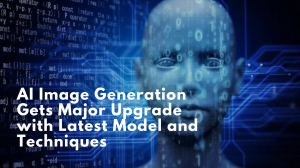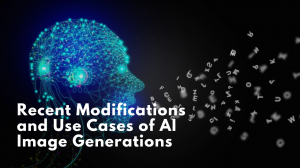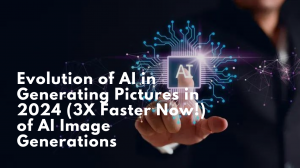The latest AI image generation models utilize cutting-edge techniques like diffusion and pruning to create stunning, realistic images with unprecedented quality
CHICAGO, ILLINOIS, UNITED STATES, February 10, 2024 /EINPresswire.com/ -- The world of AI and computer-generated images is improving at a tremendously high rate, thanks to advancements in deep learning and new AI models. One big change is a new system called Stable Diffusion made by stability.ai.It uses a special AI technique called a convolutional diffusion model to generate super realistic and unique images from text descriptions. This new system is way better than previous image generators like DALL-E because it gives more control, stability, and coherence when taking pictures.
By training it on many images, stability.ai made it possible to create detailed pictures that make sense globally and locally. The intricate images it can produce from text descriptions indicate an exciting future where AI can be a flexible, creative tool for art and design. Growth in Artificial Intelligence projects in the industry has changed the whole picture of how the digital world works.
Citing an example, Stable Diffusion could allow an artist to turn a text description like "a painting of a fox in the style of Van Gogh" into an actual image and the result is literally mind blowing. This blog post will look at how the technical innovations behind Stable Diffusion can improve AI image generation.
Evolution of AI in Generating Pictures in 2024 (3X Faster Now!)
AI has gotten much better at making images over the last decade. In the early years, AI-generated pictures looked very basic - often just fuzzy blotches of color and shapes. They did not look realistic.
However, new algorithms allowed AI to start producing clearer images. In 2014, an important advancement was Generative Adversarial Networks (GANs). This involved two neural networks - one generating pictures and the other judging how realistic they looked.
The feedback process resulted in GANs producing nicer-looking images of everyday scenes and objects. A few years later, Nvidia researchers used clever 3D modeling techniques to have AI generate convincing indoor room layouts. By 2020, some systems could edit facial photos with lifelike precision.
In 2024, leading AI labs have unveiled mind-blowing systems like DALL-E 2 and Stable Diffusion. These leverage huge datasets and advanced algorithms to produce stunning landscapes and portraits that look real, intricate artwork - all from user text descriptions.
The rate of progress keeps speeding up thanks to more training data, faster hardware, and better techniques for generating and evaluating images algorithmically. Users can now easily customize various beautiful, imaginative pictures tailor-made by AI.
Recent Modifications and Use Cases of AI Image Generations
Here are some recent developments that we have witnessed in AI-generated images.
Rapid advances in generative AI models like DALL-E 2, Stable Diffusion, and Imagen can create realistic images from text prompts.
Concerns around deep fakes and misinformation as AI image generation becomes more accessible and harder to detect
Backlash and legal issues arising from AI models trained on copyrighted data sets taken without permission
Creative exploration of AI art and new directions for digital media empowered by these models
Questions around ethics, attribution, and the societal impacts of democratized image synthesis
Emerging techniques to add conditional control, steering, and editing to enhance the quality and specificity of AI image generation
Applications in gaming, digital fashion, product design, marketing, and other visual-heavy industries augmented by AI image generators
Technologies and Algorithms Running Behind AI Image Generation
Amazing technologies and minds worked together and introduced the most fantastic models of AI till the date. Wondering what are the algorithms working behind the image generations using artificial intelligence? Below we have summarized.
Generative adversarial networks (GANs) - Two neural networks compete to generate increasingly realistic images.
Variational autoencoders (VAEs) - Learn compressed representations of images, then sample from latent space to generate new images.
Diffusion models - Generate images by learning how to reverse the effects of added noise over repeated iterations. Models like DALL-E 2 and Stable Diffusion use diffusion.
Transformers - Specialized neural networks using an attention mechanism to understand the global context within images better.
Convolutional neural networks (CNNs) - Extract hierarchical image features to classify and generate images.
Large language models - Models like GPT-3 trained on huge text data provide a semantic understanding to guide image generation from prompts.
Adversarial training - Use adversarial input images to make models more robust and generate higher-quality images.
Reinforcement learning - Use rewards/penalties a trainer model assigns to reinforce generations that better match target attributes.
Facts From The Industry Experts That You Should Know About Growing AI!
Look at the future expectations, the impact of AI- image generation of different industries, and areas to improve AI picture-making.
What AI-made images could look like in the future?
How the quality and realism of AI pictures may get better as the technology improves
How more user-friendly apps could make it easier for people to make AI images
How AI could make videos and 3D images in the future
How AI could make very customized pictures based on what users describe
How AI pictures could start being used in different industries like media and medicine
How AI images could change different industries
Stock photos - AI pictures could make real photos much cheaper
Marketing - Brands may use AI pictures in ads and social media
Entertainment - Movies and video games could use AI characters and scenes
Art - AI tools mean anyone can quickly make art, disrupting traditional art
News - AI pictures raise risks of fake news and "deep fakes"
Key research areas to improve AI picture-making
Making AI pictures more sensible, consistent, and logical
Enabling AI to depict more types of images and scenarios
Developing AI models that need less data and training
Making AI pictures more creative and original
Fixing biases in data and algorithms that lead to problematic images
Adding better content filtering and misuse detection
Some Of The Best Tools For AI-Image Generation!
Here is a list of some cool tools for AI-Image generation that you should try.
DeepArt: A website that turns photos into cool artwork, like making your picture look like famous artists painted it.
GANPaint Studio: A tool where you can change pictures by adding or removing stuff, like drawing or erasing things in a photo.
DALL-E: A smart program that makes pictures from words, like if you describe something, it can draw it for you.
RunwayML: A fun website where you can play with making cool pictures using special computer tools.
Artbreeder: A website where you can mix different pictures to make new ones, like blending photos.
DeepDream is a cool tool that makes trippy images by changing how pictures look, making them weird and artsy.
Pix2Pix: A computer program that changes one kind of picture into another, like turning a drawing into a real-looking photo.
StyleGAN: A fancy tool that makes super-realistic faces and other images, like creating lifelike people in pictures.
TensorFlow's Magenta: A smart program by Google that helps make music, art, and pictures using special computer tricks.
IBM Watson Studio: A bunch of smart tools that can help make and change pictures using computers.
ChatGPT: A helpful computer program that can write stories or captions for pictures, like telling a story about what's happening in a photo.
Google BARD (Bayesian Augmented Regression for Decoding): A cool tool by Google that makes blurry pictures clearer and sharper, like fixing fuzzy photos to make them look better.
Closing Up
The huge advances in AI image-making in the past few years have been impressive. As models like DALL-E 2 and Stable Diffusion use more training data and better techniques, the quality and variety of AI pictures keep improving.
Even though there are still some limits, AI-made images are getting so good they can look just like real photos. While there are good debates about things like copyright and misuse, it's clear this technology will impact many industries, from marketing to entertainment.
Researchers are still working on making AI pictures more sensible, less biased, and more creative. If progress keeps up at this rate, the future possibilities for AI to boost human creativity and imagination seem endless. We may be at the start of a new way to make visual art and media using intelligent algorithms.
Piyush Dhamija
CALINFO LLC
+1 312-626-5325
email us here
Visit us on social media:
Facebook
Instagram




